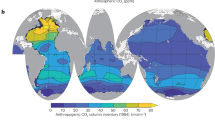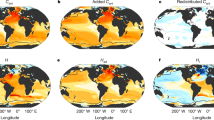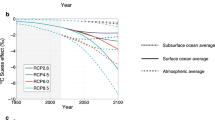Abstract
A 1995 report1 of the Intergovernmental Panel on Climate Change provides a set of illustrative anthropogenic CO2 emission models leading to stabilization of atmospheric CO2 concentrations ranging from 350 to 1,000 p.p.m. (1–4). Ocean carbon-cycle models used in calculating these scenarios assume that oceanic circulation and biology remain unchanged through time. Here we examine the importance of this assumption by using a coupled atmosphere–ocean model of global warming5 for the period 1765 to 2065. We find a large potential modification to the ocean carbon sink in a vast region of the Southern Ocean where increased rainfall leads to surface freshening and increased stratification6. The increased stratification reduces the downward flux of carbon and the loss of heat to the atmosphere, both of which decrease the oceanic uptake of anthropogenic CO2 relative to a constant-climate control scenario. Changes in the formation, transport and cycling of biological material may counteract the reduced uptake, but the response of the biological community to the climate change is difficult to predict on present understanding. Our simulation suggests that such physical and biological changes might already be occurring, and that they could substantially affect the ocean carbon sink over the next few decades.
This is a preview of subscription content, access via your institution
Access options
Subscribe to this journal
Receive 51 print issues and online access
$199.00 per year
only $3.90 per issue
Buy this article
- Purchase on Springer Link
- Instant access to full article PDF
Prices may be subject to local taxes which are calculated during checkout


Similar content being viewed by others
References
Schimel, D. et al. in Climate Change 1995 (ed. Houghton, J. T.) 76–86 (Cambridge Univ. Press, (1996)).
Schimel, D. et al. in Climate Change 1994 (ed. Houghton, J. T.) 35–71 (Cambridge Univ. Press, (1995)).
Enting, I. G., Wigley, T. M. L. & Heimann, M. Future Emissions and Concentrations of Carbon Dioxide: Key Ocean/atmosphere/land Analyses (CSIRO Division of Atmospheric Research, 31, (1994)).
Sarmiento, J. L., Le Quéré, C. & Pacala, S. W. Limiting future atmospheric carbon dioxide. Glob. Biogeochem. Cycles 9, 121–138 (1995).
Haywood, J. M., Stouffer, R. J., Wetherald, R. T., Manabe, S. & Ramaswamy, V. Transient response of a coupled model to estimate changes in greenhouse gas and sulfate concentrations. Geophys. Res. Lett. 24, 1335–1338 (1997).
Manabe, S. & Stouffer, R. J. Century-scale effects of increased atmospheric CO2on the ocean–atmosphere system. Nature 364, 215–218 (1993).
Manabe, S., Stouffer, R. J., Spelman, M. J. & Bryan, K. Transient responses of a coupled ocean–atmosphere model to gradual changes of atmospheric CO2. Part 1: annual mean response. J. Clim. 785–818 (1991).
Sarmiento, J. L. & Le Quéré, C. Oceanic carbon dioxide uptake in a model of century-scale global warming. Science 274, 1346–1350 (1996).
Coale, K. H. et al. Amassive phytoplankton bloom induced by an ecosystem-scale iron fertilization experiment in the equatorial Pacific Ocean. Nature 383, 495–501 (1996).
Johnson, K. S., Gordon, R. M. & Coale, K. H. What controls dissolved iron concentrations in the world ocean? Mar. Chem. 57, 137–161 (1997).
Sarmiento, J. L. & Orr, J. C. Three-dimensional simulations of the impact of Southern Ocean nutrient depletion on atmospheric CO2and ocean chemistry. Limnol. Oceanogr. 36, 1928–1950 (1991).
Siegenthaler, U. & Wenk, T. Rapid atmospheric CO2variations and ocean circulation. Nature 308, 624–626 (1984).
Sarmiento, J. L. & Toggweiler, J. R. Anew model for the role of the oceans in determining atmospheric pCO2. Nature 308, 621–624 (1984).
Knox, F. & McElroy, M. Changes in atmospheric CO2, influence of marine biota at high latitudes. J. Geophys. Res. 89, 4629–4637 (1984).
Sarmiento, J. L., Orr, J. C. & Siegenthaler, U. Aperturbation simulation of CO2uptake in an ocean general circulation model. J. Geophys. Res. 97, 3621–3646 (1992).
Manabe, S. & Stouffer, R. J. Multiple century response of a coupled ocean–atmosphere model to an increase of atmospheric carbon dioxide. J. Clim. 7, 5–23 (1994).
Maier-Reimer, E., Mikolajewicz, U. & Winguth, A. Future ocean uptake of CO2: interaction between ocean circulation and biology. Clim. Dyn. 12, 711–721 (1996).
Gent, P. R., Willebrand, J., McDougall, T. J. & McWilliams, J. C. Parameterizing eddy-induced tracer transports in ocean circulation models. J. Phys. Oceanogr. 25, 463–474 (1995).
Denman, K., Hofmann, E. & Marchant, H. in Climate Change 1995 (ed. Houghton, J. T.) 483–516 (Cambridge Univ. Press, (1996)).
Keeling, R. F., Najjar, R. P., Bender, M. L. & Tans, P. P. What atmospheric oxygen measurements can tell us about the global carbon cycle. Glob. Biogeochem. Cycles 7, 37–68 (1993).
Bender, M., Ellis, T., Tans, P., Francey, R. & Lowe, D. Variability in the O2/N2ratio of southern hemisphere air, 1991–1994: implications for the carbon cycle. Glob. Biogeochem. Cycles 10, 9–22 (1996).
Mitchell, J. F. B., Johns, T. C., Gregory, J. M. & Tett, S. F. B. Climate response to increasing levels of greenhouse gases and sulphate aerosols. Nature 376, 501–504 (1995).
Houghton, J. T., Callander, B. A. & Varney, S. K. (eds) Climate Change 1992 (Cambridge Univ. Press, (1992)).
Sarmiento, J. L., Murnane, R. & Quéré, C. L. Air–sea CO2transfer and the carbon budget budget of the North Atlantic. Phil. Trans. R. Soc. Lond. B 348, 211–218 (1995).
Martin, J. H., Knauer, G. A., Karl, D. M. & Broenkow, W. W. VERTEX: carbon cycling in the northeast Pacific. Deep-Sea Res. 34, 267–285 (1987).
Wanninkhof, R. Relationship between wind speed and gas exchange over the ocean. J. Geophys. Res. 97, 7373–7383 (1992).
Archer, D., Kheshgi, H. & Maier-Reimer, E. Multiple timescales for the neutralization of fossil fuel CO2. Geophys. Res. Lett. 24, 405–408 (1997).
Acknowledgements
We thank Corinne Le Quéré for adding the carbon component ot the coupled model, Fortunat Joos for providing the atmospheric CO2 figures, and Jerry Mahlman and Yasuhiro Yamanaka, as well as Klaus Keller, Francois Morel, Phillippe Tortell and Ernst Maier-Reimer, for comments. The contributions of J.L.S. and T.M.C.H. were supported by the Office of Global Programs of the National Oceanic and Atmospheric Administration, and by the National Science Foundation. The paper was written in part while J.L.S. was visiting the Bermuda Biological Station for Research with support from EXXON Corporation; J.L.S. thanks Tony Knap for making the arrangements.
Author information
Authors and Affiliations
Corresponding author
Rights and permissions
About this article
Cite this article
Sarmiento, J., Hughes, T., Stouffer, R. et al. Simulated response of the ocean carbon cycle to anthropogenic climate warming. Nature 393, 245–249 (1998). https://doi.org/10.1038/30455
Received:
Accepted:
Issue Date:
DOI: https://doi.org/10.1038/30455
This article is cited by
-
Krill body size drives particulate organic carbon export in West Antarctica
Nature (2023)
-
Picoplankton diversity in an oligotrophic and high salinity environment in the central Adriatic Sea
Scientific Reports (2023)
-
Classification of sedimentary environments and evaluation of carbon burial rates in the coastal area of Lianyungang, China, since the Late Pleistocene
Environmental Earth Sciences (2023)
-
Phytoplankton responses to changing temperature and nutrient availability are consistent across the tropical and subtropical Atlantic
Communications Biology (2022)
-
Decadal Variability of Satellite-Derived Air–Sea CO2 Flux in Southwestern Part of the Bay of Bengal
Ocean Science Journal (2022)
Comments
By submitting a comment you agree to abide by our Terms and Community Guidelines. If you find something abusive or that does not comply with our terms or guidelines please flag it as inappropriate.



